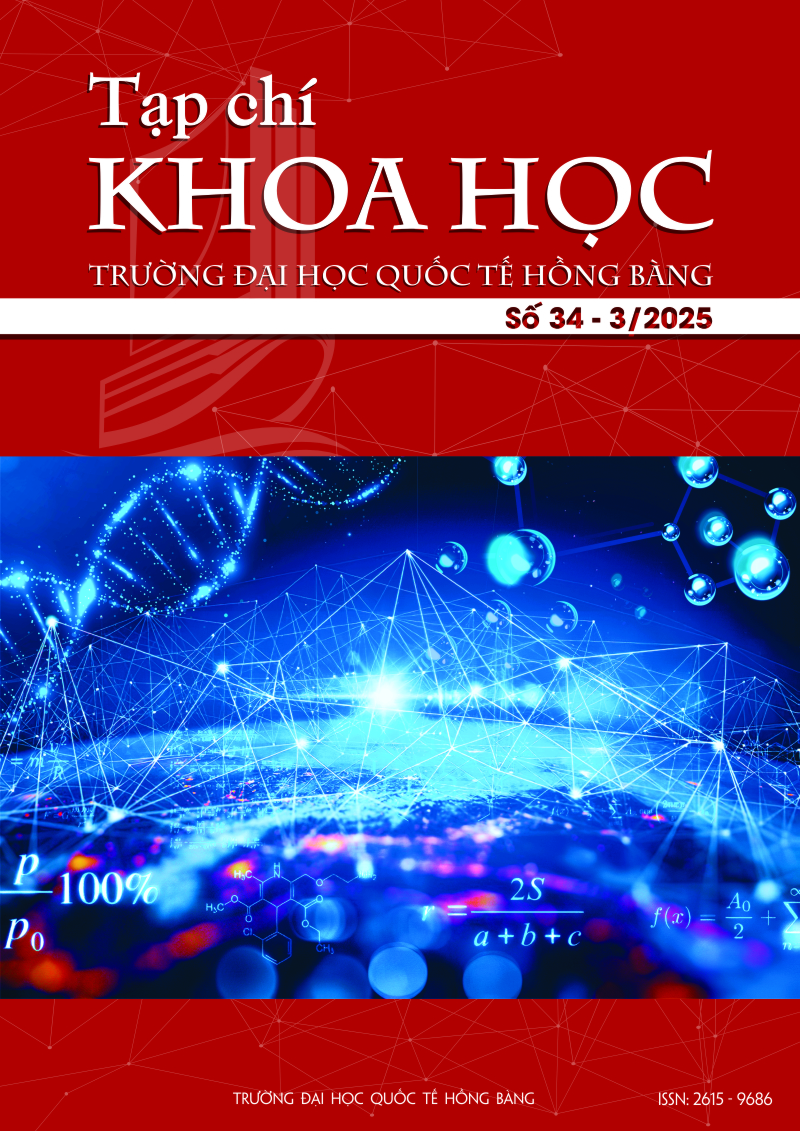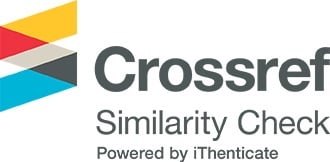Nghiên cứu tổng hợp và khảo sát hoạt tính kháng khuẩn của dẫn chất 3-aryl-2H-1,3-benzothiazin-2,4(3H)-dion
Các tác giả
DOI: https://doi.org/10.59294/HIUJS.34.2025.744Từ khóa:
1,3-benzothiazin, tổng hợp, kháng khuẩn, Staphylococccus faecalisTóm tắt
Đặt vấn đề: Benzothiazin là nhóm hợp chất dược lý đa tác dụng với nhiều ứng dụng trong điều trị các bệnh lý khác nhau: kháng viêm, chống ung thư, giảm đau và bảo vệ tim mạch, … Ngoài ra, các hợp chất này còn có hiệu quả trong việc kháng nhiều loại vi khuẩn và vi nấm. Mục tiêu: Tổng hợp và đánh giá hoạt tính kháng khuẩn các dẫn chất 3-aryl-2H-1,3-benzothiazin-2,4(3H)-dion. Đối tượng và phương pháp nghiên: Các dẫn chất 3-aryl-2H-1,3-benzothiazin-2,4(3H)-dion được tổng hợp từ nguyên liệu ban đầu là acid thiosalicylic và các dẫn chất anilin qua hai giai đoạn chính: tạo liên kết amid và tổng hợp các dẫn chất 3-aryl-2H-1,3-benzothiazion-2,4(3H)-dion. Cấu trúc của các chất trung gian và sản phẩm được xác định bằng nhiệt độ nóng chảy, phổ UV, IR, MS, NMR. Phương pháp thử hoạt tính kháng khuẩn sử dụng phương pháp khuếch tán trong thạch và phương pháp pha loãng. Kết quả: Từ acid thiosalicylic đã tổng hợp được 4 dẫn chất 1,3-benzothiazin-2,4-dion gồm: 3-phenyl-2H-1,3-benzothiazin-2,4(3H)-dion, 3-(2-clorophenyl)-2H-1,3-benzothiazin-2,4-dion, 3-(3-clorophenyl)-2H-1,3-benzoxazin-2,4(3H)-dion, 3-(4-clorophenyl)-2H-1,3-benzoxazin-2,4(3H)-dion các chất này đã được xác định cấu trúc dựa trên các phổ IR, MS, NMR. Hiệu suất các phản ứng trung bình đạt 45.54%. Kết quả đánh giá hoạt tính kháng khuẩn cho thấy cả bốn dẫn chất đều có hoạt tính kháng khuẩn đối với Staphylococcus aureus và Staphylococcus aureus kháng methicillin (MRSA), nhưng không có hiệu quả đối với Escherichia coli và Pseudomonas aeruginosa. Kết luận: Đã tổng hợp được 4 dẫn chất 3-aryl-2H-1,3-benzothiazin-2,4(3H)-dion. Những hợp chất này có tác dụng kháng khuẩn khá tốt, trong đó sản phẩm 3-phenyl-2H-1,3-benzothiazin-2,4(3H)-dion (2a) có khả năng kháng S.aureus và, S.aureus kháng methicilin với giá trị MIC khá thấp (8 µg/mL).
Abstract
Background: Benzothiazine is a group of pharmacological compounds with diverse bioactivities and has numerous applications in the treatment of various diseases, including anti-inflammatory, anticancer, analgesic, and cardiovascular protective effects. In addition, these compounds have shown effectiveness in combating a wide range of bacteria and fungi. Objectives: Synthesis and evaluation of the antibacterial activity of 3-aryl-2H-1,3-benzothiazine-2,4(3H)-dion derivatives. Materials and methods: The 3-aryl-2H-1,3-benzothiazine-2,4(3H)-dione derivatives were synthesized from thiosalicylic acid and aniline derivatives through two main stages: amide bond formation and the synthesis of 1,3-benzothiazine-2,4-dione derivatives. The structures of the intermediates and products were determined using melting point, UV spectrum, IR spectrum, MS spectrum, and 1H-NMR, 13C-NMR spectrum. The antibacterial activity was tested using the agar diffusion method and dilution method. Result: From thiosalicylic acid, four 1,3-benzothiazine-2,4-dione derivatives were synthesized, incuding 3-phenyl-2H-1,3-benzothiazine-2,4(3H)-dione, 3-(2-chlorophenyl)-2H-1,3-benzothiazine-2,4-dione, 3-(3-chlorophenyl)-2H-1,3-benzothiazine-2,4(3H)-dione, and 3-(4-chlorophenyl)-2H-1,3-benzothiazine-2,4(3H)-dione. These compounds were structurally characterized using IR, MS, and NMR spectroscopy. "The average reaction yield is 45.54%. The antimicrobial activity evaluation results indicate that all four derivatives exhibit antibacterial activity against Staphylococcus aureus and methicillin-resistant Staphylococcus aureus (MRSA), but show no efficacy against Escherichia coli and Pseudomonas aeruginosa. Conclusion: Four 3-aryl-2H-1,3-benzothiazine-2,4(3H)-dione derivatives have been synthesized. These compounds exhibit good antibacterial activity, with compound 3-phenyl-2H-1,3-benzothiazin-2,4(3H)-dion (2a) showing the ability to inhibit S. aureus and methicillin-resistant S. aureus (MRSA) with a relatively low MIC value (8 µg/mL).
Tài liệu tham khảo
[1] Ewies, Ewies F., and Fatma AA El‐Hag. "Synthesis, reactions, and antimicrobial evaluations of new benzo [e][1, 3] thiazine derivatives." Journal of Heterocyclic Chemistry, Vol. 57, No. 1,pp. 163-172, 2020. DOI:10.1002/jhet.3759
DOI: https://doi.org/10.1002/jhet.3759[2] Ramzan, Farhat, et al. "Synthesis, molecular docking, and biological evaluation of a new series of benzothiazinones and their benzothiazinyl acetate derivatives as anticancer agents against MCF-7 human breast cancer cells and as anti-inflammatory agents.", ACS omega, Vol 8, No.7,pp. 6650-6662, 2023. DOI:10.1021/acsomega.2c07153
DOI: https://doi.org/10.1021/acsomega.2c07153[3] Tliba, S., Fedaoui, D., Sousa, J. L. C., Silva, A. M. S., and Messaoud, L. “Synthesis and characterization of novel benzothiazinonic N-acylhydrazone derivatives”, Polycyclic Aromatic Compounds, Vol 11,pp. 1–14, 2024. DOI:10.1080/10406638.2024.2445151.
DOI: https://doi.org/10.1080/10406638.2024.2445151[4] Salih, T. M., et al. “Thiazine: Synthesis and biological activity”, Magazine of Al-Kufa University for Biology, Vol 16, No. 3, pp. 80-87, 2024. DOI:10.36320/ajb/v16.i3.17436
DOI: https://doi.org/10.36320/ajb/v16.i3.17436[5] Mir, S., Dar, A. M., and Dar, B. A., “Synthetic strategies of benzothiazines: a mini review”. Mini-Reviews in Organic Chemistry, Vol 17, No 2, pp. 148-157, 2020. DOI: 10.2174/1570193X16666181206101439
DOI: https://doi.org/10.2174/1570193X16666181206101439[6] Li, J., et al., “Design and synthesis of 1,3-benzothiazinone derivatives as potential anti-inflammatory agents”, Bioorganic & Medicinal Chemistry, Vol 28, No 11, pp. 115526, 2020. DOI: 10.1016/j.bmc.2020.115526
DOI: https://doi.org/10.1016/j.bmc.2020.115526[7] Smith, J. D., and Johnson, R. A., “Synthesis of Benzothiazin Derivatives via Halogenation and Cyclization Reactions”, Journal of Organic Chemistry, Vol 85, No 12, pp. 3502-3510, 2020. DOI: 10.1021/jo0123456.
[8] Nosova, E. V., Lipunova, G. N., Charushin, V. N., and Chupakhin, O. N., “Synthesis and biological activity of 2-amino- and 2-aryl(heteryl) substituted 1,3-benzothiazin-4-ones”, Mini Reviews in Medicinal Chemistry, Vol 19. No 12, pp. 999–1014, 2019. DOI: 10.2174/1389557518666181015151801
DOI: https://doi.org/10.2174/1389557518666181015151801[9] Brown, H. C., and Sykes, J. D., “Application of SOCl2 for Halogenation of Aromatic Compounds”, Synthetic Methods in Organic Chemistry, Vol 45, No 3, pp. 112-120, 2018. DOI: 10.1002/syn1234.
[10] Williams, D. F., and Anderson, P. S., “Ethylchloroformiate as a Reagent for the Formation of Benzothiazine Rings”, Tetrahedron Letters, Vol 60, No 2, pp. 125-130, 2019. DOI: 10.1016/j.tetlet.2018.12.039.
[11] Reetu, R., Gujjarappa, R., and Malakar, C. C., “Recent advances in synthesis and medicinal evaluation of 1,2-benzothiazine analogues”, Asian Journal of Organic Chemistry, Vol 11, pp. e202200163, 2022. DOI:10.1002/ajoc.202200163.
DOI: https://doi.org/10.1002/ajoc.202200163[12] Liu, Z., Huang, X., and Yang, Y., “Antibacterial activity of benzothiazine derivatives and their potential use against Staphylococcus aureus”, Antibiotics, Vol 9, No 3, pp. 134, 2020. DOI:10.3390/antibiotics9030134
[13] Smith, J., Johnson, A., and Wang, L., “Effect of halogen substituents on the antibacterial activity of benzothiazine derivatives”, Journal of Medicinal Chemistry, Vol 62, No 4, pp. 1234-1245, 2019. DOI:10.1021/jm8001234
[14] Patel, S., Kumar, V., and Singh, R., “Structure-activity relationship of substituted benzothiazines and their antibacterial potential”, European Journal of Medicinal Chemistry, Vol 208, pp. 112835, 2021. DOI:10.1016/j.ejmech.2020.112835
DOI: https://doi.org/10.1016/j.ejmech.2020.112835Tải xuống
Tải xuống: 64











